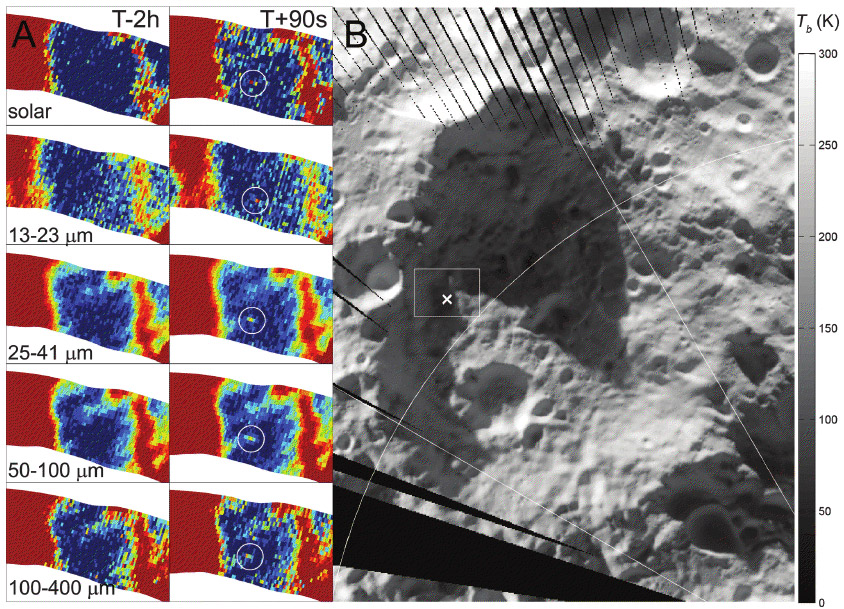Difference between revisions of "October 23, 2010"
| Line 1: | Line 1: | ||
__NOTOC__ | __NOTOC__ | ||
=A Flash of Steam= | =A Flash of Steam= | ||
| − | |||
<!-- ws:start:WikiTextHeadingRule:1:<h1> --> | <!-- ws:start:WikiTextHeadingRule:1:<h1> --> | ||
<!-- ws:start:WikiTextLocalImageRule:16:<img src="/file/view/LPOD-Oct23-10.jpg/172912309/LPOD-Oct23-10.jpg" alt="" title="" /> -->[[File:LPOD-Oct23-10.jpg|LPOD-Oct23-10.jpg]]<!-- ws:end:WikiTextLocalImageRule:16 --><br /> | <!-- ws:start:WikiTextLocalImageRule:16:<img src="/file/view/LPOD-Oct23-10.jpg/172912309/LPOD-Oct23-10.jpg" alt="" title="" /> -->[[File:LPOD-Oct23-10.jpg|LPOD-Oct23-10.jpg]]<!-- ws:end:WikiTextLocalImageRule:16 --><br /> | ||
| − | <em>image of Cabeus crater from [http://www.sciencemag.org/cgi/content/abstract/330/6003/477 Hayne and colleagues], Science, 22 Oct, 2010</em><br /> | + | <em>image of Cabeus crater from [http://www.sciencemag.org/cgi/content/abstract/330/6003/477" rel="nofollow Hayne and colleagues], Science, 22 Oct, 2010</em><br /> |
<br /> | <br /> | ||
| − | The latest issue of <em>Science</em> magazine (with a great [http://www.sciencemag.org/content/vol330/issue6003/cover.dtl cover]) has six [http://www.sciencemag.org/cgi/content/summary/330/6003/434 articles] about the discoveries from the impact of LCROSS with the Moon, 12 months ago. This illustration from an article about [http://diviner.ucla.edu/ DIVINER] detection of the thermal anomaly (left hand color column is 2 hrs before the impact; the right side is 90 seconds after) shows the strongest signal in the 50-100 micron channel. From analysis of all the data the DIVINER team deduced that the impact raised the temperature of a few hundred square meters of the surface to nearly1000 kelvin, releasing about 400 kg of water. This is vastly more than the zero amount previously thought to exist on the Moon, but it is still a small amount, about 6% by mass of the top few meters of the soil in the darkly shadowed impact point. The distribution of ice is confusingly spotty, with none in some very cold places, but strangely, hydrogen also was found in places that receive some sunshine. One investigator said that we may never figure it out until we go there.<br /> | + | The latest issue of <em>Science</em> magazine (with a great [http://www.sciencemag.org/content/vol330/issue6003/cover.dtl" rel="nofollow cover]) has six [http://www.sciencemag.org/cgi/content/summary/330/6003/434" rel="nofollow articles] about the discoveries from the impact of LCROSS with the Moon, 12 months ago. This illustration from an article about [http://diviner.ucla.edu/" rel="nofollow DIVINER] detection of the thermal anomaly (left hand color column is 2 hrs before the impact; the right side is 90 seconds after) shows the strongest signal in the 50-100 micron channel. From analysis of all the data the DIVINER team deduced that the impact raised the temperature of a few hundred square meters of the surface to nearly1000 kelvin, releasing about 400 kg of water. This is vastly more than the zero amount previously thought to exist on the Moon, but it is still a small amount, about 6% by mass of the top few meters of the soil in the darkly shadowed impact point. The distribution of ice is confusingly spotty, with none in some very cold places, but strangely, hydrogen also was found in places that receive some sunshine. One investigator said that we may never figure it out until we go there.<br /> |
<br /> | <br /> | ||
| − | <em>[mailto:tychocrater@yahoo.com Chuck Wood]</em><br /> | + | <em>[mailto:tychocrater@yahoo.com" rel="nofollow Chuck Wood]</em><br /> |
<br /> | <br /> | ||
<strong>Related Links</strong><br /> | <strong>Related Links</strong><br /> | ||
| Line 14: | Line 13: | ||
<br /> | <br /> | ||
<hr /> | <hr /> | ||
| − | <div>You can support LPOD when you buy any book from Amazon thru [http://www.lpod.org/?page_id=591 LPOD!]<br /> | + | <div>You can support LPOD when you buy any book from Amazon thru [http://www.lpod.org/?page_id=591" rel="nofollow LPOD!]<br /> |
</div> | </div> | ||
| − | |||
---- | ---- | ||
===COMMENTS?=== | ===COMMENTS?=== | ||
Click on this icon [[image:PostIcon.jpg]] at the upper right to post a comment. | Click on this icon [[image:PostIcon.jpg]] at the upper right to post a comment. | ||
Revision as of 22:08, 4 January 2015
A Flash of Steam

image of Cabeus crater from " rel="nofollow Hayne and colleagues, Science, 22 Oct, 2010
The latest issue of Science magazine (with a great " rel="nofollow cover) has six " rel="nofollow articles about the discoveries from the impact of LCROSS with the Moon, 12 months ago. This illustration from an article about " rel="nofollow DIVINER detection of the thermal anomaly (left hand color column is 2 hrs before the impact; the right side is 90 seconds after) shows the strongest signal in the 50-100 micron channel. From analysis of all the data the DIVINER team deduced that the impact raised the temperature of a few hundred square meters of the surface to nearly1000 kelvin, releasing about 400 kg of water. This is vastly more than the zero amount previously thought to exist on the Moon, but it is still a small amount, about 6% by mass of the top few meters of the soil in the darkly shadowed impact point. The distribution of ice is confusingly spotty, with none in some very cold places, but strangely, hydrogen also was found in places that receive some sunshine. One investigator said that we may never figure it out until we go there.
" rel="nofollow Chuck Wood
Related Links
Rükl plate 73
COMMENTS?
Click on this icon File:PostIcon.jpg at the upper right to post a comment.



